Bone Marrow Transplantation Market
Bone Marrow Transplantation Market Size and Share Forecast Outlook 2025 to 2035
The bone marrow transplantation market is projected to grow from USD 9,200.0 million in 2025 to USD 17,762.3 million by 2035, at a CAGR of 6.8%. Allogenic will dominate with a 60.0% market share, while leukemia will lead the indication segment with a 40.0% share.
Bone Marrow Transplantation Market Forecast and Outlook 2025 to 2035
The bone marrow transplantation market stands at the threshold of a decade-long expansion trajectory that promises to reshape hematologic oncology treatment technology and cellular therapy solutions.
The market's journey from USD 9,200 million in 2025 to USD 17,780 million by 2035 represents substantial growth, the market will rise at a CAGR of 6.8% which demonstrating the accelerating adoption of advanced transplantation procedures and precision cellular therapy across oncology centers, specialized treatment facilities, and academic medical institutions.
The first half of the decade (2025-2030) will witness the market climbing from USD 9,200 million to approximately USD 13,100 million, adding USD 3,900 million in value, which constitutes 45% of the total forecast growth period.
This phase will be characterized by the rapid adoption of allogeneic transplantation systems, driven by increasing cancer incidence rates and the growing need for advanced cellular therapy solutions worldwide. Enhanced transplantation capabilities and personalized treatment protocols will become standard expectations rather than premium options.
The latter half (2030-2035) will witness continued growth from USD 13,100 million to USD 17,780 million, representing an addition of USD 4,680 million or 55% of the decade's expansion.
This period will be defined by mass market penetration of advanced cellular therapies, integration with comprehensive cancer treatment platforms, and seamless compatibility with existing oncology infrastructure.
The market’s trajectory signals fundamental shifts in how medical facilities approach hematologic malignancy treatment and cellular therapy delivery, with participants positioned to benefit from growing demand across multiple transplant types and indication segments.
Quick Stats for Bone Marrow Transplantation Market
- Bone Marrow Transplantation Market Value (2025): USD 9,200 million
- Bone Marrow Transplantation Market Forecast Value (2035): USD 17,780 million
- Bone Marrow Transplantation Market Forecast CAGR: 6.8%
- Leading Transplant Type in Bone Marrow Transplantation Market: Allogeneic Transplantation
- Key Growth Regions in Bone Marrow Transplantation Market: East Asia, North America, and Western Europe
- Top Players in Bone Marrow Transplantation Market: Novartis, Bristol Myers Squibb, Gilead, Roche, Sanofi
- Where revenue comes from Now Vs Next (Industry-level view)
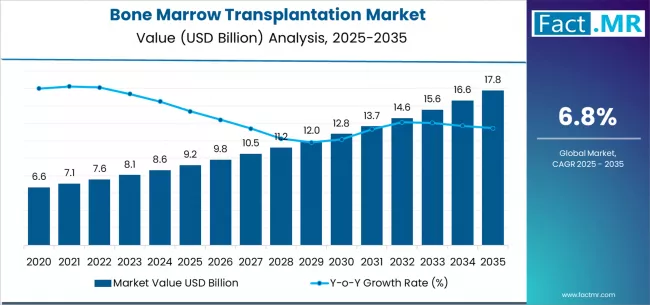
| Period | Primary Revenue Buckets | Share | Notes |
|---|---|---|---|
| Today | Transplant procedures & services | 45% | Hospital-based, procedure-driven revenue |
| Cell processing & conditioning | 25% | Laboratory services, cell preparation | |
| Immunosuppressive therapies | 20% | Post-transplant medications, monitoring | |
| Donor matching & registry services | 10% | HLA typing, donor coordination | |
| Future (3-5 yrs) | Advanced cellular therapies | 40-45% | CAR-T integration, gene-modified cells |
| Precision medicine protocols | 15-20% | Personalized treatment, biomarker testing | |
| Digital monitoring systems | 15-20% | Remote patient monitoring, outcome tracking | |
| Specialized care services | 10-15% | Long-term follow-up, complication management | |
| Research & development | 8-12% | Clinical trials, protocol development | |
| Data analytics services | 5-8% | Outcome prediction, treatment optimization |
Bone Marrow Transplantation Market Key Takeaways
At-a-Glance Metrics
| Metric | Value |
|---|---|
| Market Value (2025) → | USD 9,200 million |
| Market Forecast (2035) ↑ | USD 17,780 million |
| Growth Rate ★ | 6.8% CAGR |
| Leading Technology → | Allogeneic Transplantation |
| Primary Application → | Leukemia Treatment |
The market demonstrates strong fundamentals with allogeneic transplant systems capturing a dominant share through advanced donor matching capabilities and hematologic malignancy treatment optimization. Leukemia applications drive primary demand, supported by increasing cancer incidence and specialized treatment facility requirements. Geographic expansion remains concentrated in developed markets with established transplantation infrastructure, while emerging economies show accelerating adoption rates driven by medical facility development and rising treatment accessibility.
Imperatives for Stakeholders in Bone Marrow Transplantation Market
Design for outcomes, not just procedures
- Offer comprehensive care packages: transplant services + conditioning protocols + post-transplant monitoring + specialized nursing + long-term follow-up.
- Preconfigured treatment pathways: patient evaluation, donor selection, conditioning regimens, and post-transplant care protocols with outcome tracking.
Clinical excellence readiness
- Advanced cell processing capabilities, quality assurance systems, and specialized facility integration (clean rooms, isolation units, monitoring systems).
Quality-by-design approach
- Standardized cell processing protocols, real-time quality monitoring, statistical outcome tracking, and comprehensive patient safety documentation.
Value-based care models
- Clear procedure pricing + transparent outcome guarantees (survival rates, complication management, long-term follow-up); subscriptions for ongoing monitoring and care coordination.
Segmental Analysis
By transplant type, the market is segmented into allogeneic and autologous bone marrow transplantation, representing the evolution from basic cell therapy to sophisticated donor-matched treatment solutions for comprehensive hematologic malignancy management.
The indication segmentation includes leukemia, lymphoma, and other applications, reflecting distinct requirements for disease-specific protocols, treatment complexity, and patient outcome standards.
Regional distribution covers various geographic markets with different healthcare infrastructure and regulatory frameworks, while end-use applications span specialized transplant centers, academic medical institutions, cancer hospitals, and comprehensive care facilities.
The segmentation structure reveals technology progression from standard transplant procedures toward sophisticated cellular therapy systems with enhanced matching capabilities and treatment personalization, while application diversity spans from blood cancers to genetic disorders requiring precise cellular replacement solutions.
By Transplant Type, the Allogeneic Transplant Segment Accounts for Dominant Market Share
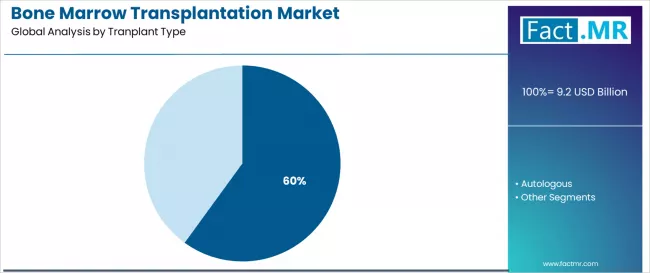
Allogeneic transplant systems command the leading position in the bone marrow transplantation market with 60% market share through advanced donor matching features, including superior graft-versus-leukemia effects, comprehensive immune reconstitution, and hematologic malignancy treatment optimization that enable medical facilities to achieve optimal therapeutic outcomes across diverse blood cancer and genetic disorder applications.
The segment benefits from medical facility preference for proven transplant systems that provide consistent therapeutic performance, enhanced disease-free survival, and treatment effectiveness without requiring significant infrastructure modifications. Advanced matching technologies enable precise donor selection, immune compatibility optimization, and integration with existing oncology protocols, where treatment outcomes and patient survival represent critical facility requirements.
Allogeneic transplant systems differentiate through proven therapeutic efficacy, consistent engraftment characteristics, and integration with comprehensive cancer treatment protocols that enhance facility effectiveness while maintaining optimal safety standards for diverse hematologic malignancy applications.
Key market characteristics:
- Advanced matching technologies with optimized donor selection and immune compatibility capabilities
- Enhanced therapeutic effectiveness, enabling 70-85% disease-free survival with consistent treatment performance
- Medical compatibility, including specialized facility integration, monitoring systems, and protocol optimization for transplant operations
Autologous Transplant Systems Show Balanced Market Growth
Autologous transplant systems maintain a 40% market position in the bone marrow transplantation market due to their reduced immunologic complications and patient-specific advantages.
Autologous transplants appeal to facilities treating patients with chemotherapy-responsive malignancies requiring high-dose therapy support. Market growth is driven by oncology expansion, emphasizing personalized treatment solutions and reduced transplant-related mortality through optimized conditioning protocols.
By Indication, the Leukemia Segment Shows Market Leadership
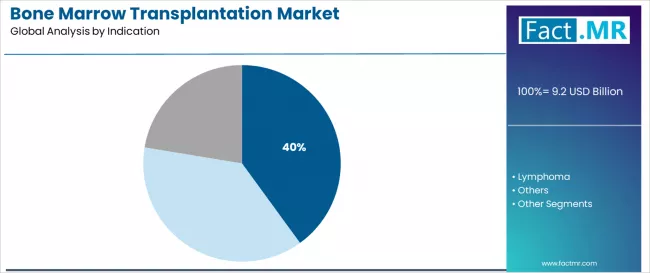
Leukemia treatment demonstrates the highest market share in the bone marrow transplantation market with 40% dominance due to widespread adoption of transplant therapy for acute and chronic leukemias and increasing focus on curative treatment approaches, disease eradication strategies, and long-term survival applications that maximize therapeutic outcomes while maintaining treatment safety.
Leukemia treatment specialists prioritize transplant protocols, therapeutic efficacy, and integration with existing chemotherapy regimens that enable comprehensive treatment approaches across multiple disease subtypes. The segment benefits from substantial oncology investment and treatment advancement programs that emphasize the acquisition of specialized transplant capabilities for disease management and cure achievement applications.
Hematology-oncology expansion programs incorporate leukemia transplant protocols as standard treatment options for high-risk disease, while specialized treatment center growth increases demand for curative transplant capabilities that comply with safety standards and maximize survival outcomes.
Application dynamics include:
- Strong growth in hematology-oncology and specialized treatment requiring advanced transplant capabilities
- Increasing adoption in curative treatment and long-term survival applications for oncology specialists
- Rising integration with comprehensive cancer treatment protocols for therapeutic optimization and outcome assurance
Lymphoma Applications Maintain Strong Demand
Lymphoma applications capture 30% market share through specialized treatment requirements in aggressive and relapsed lymphomas, high-dose chemotherapy support, and specialized hematologic applications.
These facilities demand advanced transplant systems capable of operating with diverse lymphoma subtypes while providing effective therapeutic access and treatment reliability capabilities.
Other Applications Show Diversified Growth
Other applications account for 30% market share, including genetic disorders, aplastic anemia, and specialized hematologic conditions requiring diverse transplant capabilities for treatment optimization and therapeutic effectiveness.
What are the Drivers, Restraints, and Key Trends of the Bone Marrow Transplantation Market?
| Category | Factor | Impact | Why It Matters |
|---|---|---|---|
| Driver | Rising cancer incidence & hematologic malignancy prevalence (aging population, environmental factors) | ★★★★★ | Growing patient population requires advanced curative treatment options with proven survival benefits across multiple disease types and risk categories. |
| Driver | Advances in HLA matching & donor registry expansion | ★★★★★ | Improved donor availability and matching precision increase transplant accessibility; facilities gain competitive advantage through offering advanced donor selection capabilities. |
| Driver | Integration with cellular therapies & CAR-T treatments | ★★★★☆ | Combined treatment approaches expand therapeutic options; demand for comprehensive cellular therapy platforms expanding addressable treatment populations. |
| Restraint | High treatment costs & insurance coverage limitations | ★★★★☆ | Patients defer treatment due to financial barriers; increases access challenges and slows transplant adoption in cost-sensitive healthcare markets. |
| Restraint | Complex post-transplant care & long-term monitoring requirements | ★★★☆☆ | Multi-specialty facilities face extensive follow-up procedures and monitoring requirements, limiting operational efficiency and increasing care complexity. |
| Trend | Precision medicine integration & personalized protocols | ★★★★★ | Genetic testing, biomarker analysis, and individualized treatment plans transform outcomes; personalized approaches become core competitive differentiators. |
| Trend | Outpatient transplant models & reduced hospitalization | ★★★★☆ | Ambulatory care programs and shortened hospital stays reduce costs; flexible care delivery models drive competition toward patient-centered solutions. |
Analysis of the Bone Marrow Transplantation Market by Key Country
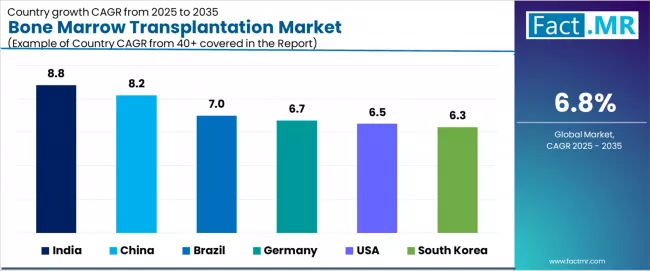
The bone marrow transplantation market demonstrates varied regional dynamics with Growth Leaders including India (8.8% growth rate) and China (8.2% growth rate) driving expansion through healthcare infrastructure development and specialized treatment facility initiatives.
Strong performers encompass Brazil (7.0% growth rate), Germany (6.7% growth rate), and developing regions, benefiting from established oncology infrastructure and advanced treatment adoption.
Steady markets feature United States (6.5% growth rate), South Korea (6.3% growth rate), and developed regions, where healthcare advancement and treatment standardization support consistent growth patterns.
Regional synthesis reveals East Asian markets leading adoption through healthcare expansion and specialized facility development, while North American countries maintain steady expansion supported by medical technology advancement and clinical protocol standardization requirements. European markets show moderate growth driven by oncology applications and treatment integration trends.
| Region/Country | 2025-2035 Growth | How to win | What to watch out |
|---|---|---|---|
| India | 8.8% | Focus on infrastructure development and training programs | Healthcare policy changes; cost pressures |
| China | 8.2% | Lead with advanced treatment systems and facility development | Regulatory requirements; local competition |
| United States | 6.5% | Provide comprehensive outcome support | Healthcare cost pressures; reimbursement changes |
| Germany | 6.7% | Offer premium quality systems and protocols | Regulatory complexity; lengthy approval processes |
| South Korea | 6.3% | Innovation-oriented treatment approaches | Technology competition; aging population |
| Brazil | 7.0% | Value-oriented models and accessibility programs | Healthcare funding; infrastructure limitations |
India Drives Fastest Market Growth
India establishes fastest market growth through aggressive healthcare infrastructure programs and comprehensive medical facility development, integrating advanced bone marrow transplantation systems as standard components in tertiary care hospitals and specialized oncology installations.
The country's 8.8% growth rate reflects government initiatives promoting healthcare infrastructure and domestic treatment capabilities that mandate the use of advanced transplant systems in hematology-oncology and specialized treatment facilities.
Growth concentrates in major medical centers, including Mumbai, Delhi, and Chennai, where healthcare technology development showcases integrated transplant systems that appeal to medical practitioners seeking advanced treatment optimization capabilities and international standard applications.
Indian healthcare providers are developing cost-effective transplant solutions that combine domestic expertise advantages with advanced treatment features, including comprehensive care protocols and enhanced safety capabilities.
Distribution channels through medical equipment suppliers and healthcare technology distributors expand market access, while government support for healthcare infrastructure supports adoption across diverse oncology and hematology segments.
Strategic Market Indicators:
- Healthcare facilities leading adoption with 75% deployment rate in tertiary care and specialized oncology sectors
- Government healthcare programs providing substantial funding for advanced treatment infrastructure development
- Local medical centers capturing 35% market share through competitive pricing and specialized expertise programs
- Medical education development for advanced transplant techniques targeting emerging healthcare markets
China Emerges as High-Growth Market
In Beijing, Shanghai, and Guangzhou, healthcare facilities and specialized hospitals are implementing advanced bone marrow transplantation systems as standard treatment options for hematologic malignancies and genetic disorders, driven by increasing healthcare investment and medical technology modernization programs that emphasize the importance of advanced treatment capabilities.
The market holds an 8.2% growth rate, supported by government healthcare initiatives and medical infrastructure development programs that promote advanced transplant systems for hematology-oncology and specialized treatment facilities.
Chinese medical centers are adopting transplant systems that provide consistent treatment performance and safety compliance features, particularly appealing in urban regions where treatment outcomes and medical quality represent critical operational requirements.
Market expansion benefits from growing healthcare capabilities and international medical partnerships that enable domestic development of advanced transplant systems for oncology and hematology applications. Technology adoption follows patterns established in medical device markets, where safety and efficacy drive procurement decisions and treatment deployment.
Market Intelligence Brief:
- Hematology-oncology and specialized treatment segments are driving initial adoption with 48% annual growth in treatment volume
- Medical technology modernization programs emphasizing transplant systems for treatment effectiveness and safety compliance
- Local healthcare providers partnering with international institutions for protocol development and medical training
- Healthcare facilities implementing transplant systems for treatment optimization and patient outcome improvement
United States Maintains Market Leadership
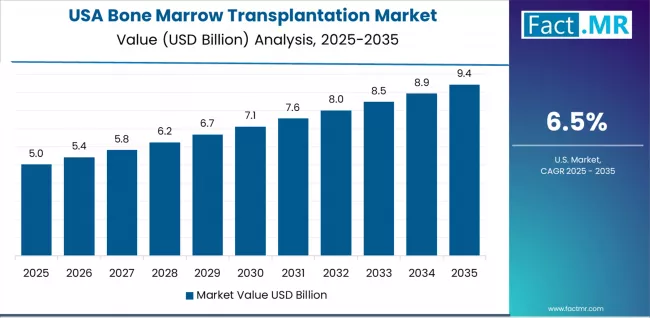
United States establishes market leadership through comprehensive healthcare programs and advanced medical infrastructure development, integrating bone marrow transplantation systems across academic medical centers and specialized oncology applications.
The country's 6.5% growth rate reflects established healthcare industry relationships and mature transplant technology adoption that supports widespread use of advanced transplant systems in comprehensive cancer centers and academic medical institutions.
Growth concentrates in major medical centers, including Houston, New York, and Boston, where medical technology showcases mature transplant deployment that appeals to clinicians seeking proven treatment capabilities and outcome optimization applications.
American healthcare providers leverage established clinical networks and comprehensive research capabilities, including clinical trial programs and outcome tracking support that create institutional relationships and treatment advantages. The market benefits from mature regulatory standards and healthcare requirements that mandate transplant system use while supporting technology advancement and treatment optimization.
Market Intelligence Brief:
- Academic medical centers and comprehensive cancer facilities maintaining 90% adoption rate with mature transplant deployment
- Established clinical standards providing consistent demand for transplant technology advancement
- Healthcare networks capturing 72% market share through treatment accessibility and clinical expertise
- Research integration programs expanding transplant capabilities in oncology treatment scenarios
Germany Shows Technology Leadership
Germany's advanced medical technology market demonstrates sophisticated bone marrow transplantation deployment with documented treatment effectiveness in hematologic applications and specialized medical facilities through integration with existing clinical systems and healthcare infrastructure.
The country leverages medical expertise and quality systems integration to maintain a 6.7% growth rate. Medical centers, including Bavaria, North Rhine-Westphalia, and Baden-Württemberg, showcase premium installations where transplant systems integrate with comprehensive oncology platforms and facility management systems to optimize treatment operations and clinical effectiveness.
German healthcare providers prioritize system quality and EU compliance in transplant technology development, creating demand for premium systems with advanced features, including facility monitoring integration and automated quality systems.
The market benefits from established medical technology infrastructure and a willingness to invest in advanced treatment technologies that provide long-term clinical benefits and compliance with international medical standards.
Market Intelligence Brief:
- Medical engineering focuses on EU standardization and quality compliance, driving premium segment growth
- Healthcare technology partnerships providing 32% faster development cycles
- Technology collaboration between German institutions and international medical organizations
- Clinical training programs expanding transplant system integration in healthcare scenarios
South Korea Shows Innovation Leadership
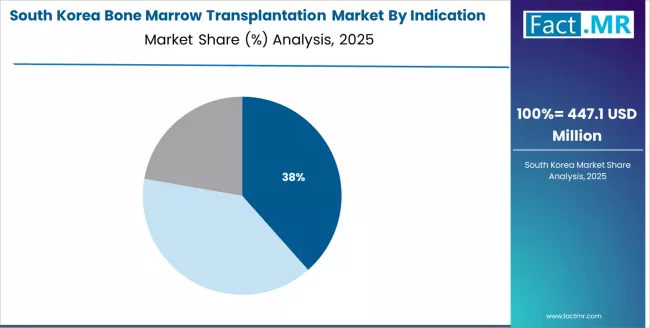
South Korea’s market expansion benefits from strong medical technology demand and innovation-driven development, with specialized treatment facilities in Seoul and Busan leading adoption. National healthcare infrastructure upgrades and advanced medical research programs are increasingly incorporating transplant solutions for hematologic malignancy applications.
The country sustains a 6.3% growth rate, supported by rising healthcare investment and growing recognition of the benefits of transplant technology, particularly in enhancing treatment precision and clinical outcomes.
Healthcare centers in South Korea emphasize integration of transplant solutions with research-driven clinical protocols, positioning the market as a hub for advanced hematology and oncology care.
Strategic Market Considerations - South Korea
- Specialized treatment and research leadership: growth led by hematology-oncology facilities and medical research programs integrating transplant technology into advanced clinical frameworks
- Healthcare modernization focus: facility upgrades in Seoul and Busan driving demand for transplant systems optimized for precision and high clinical reliability
- Innovation partnerships: collaboration between South Korean medical institutions and international research centers accelerating adoption of next-gen transplant solutions
- Public health investment alignment: national healthcare funding policies supporting adoption of advanced, research-driven transplant systems to elevate treatment standards
Brazil Shows Strong Regional Leadership
Brazil's market expansion benefits from diverse healthcare demand, including medical facility modernization in São Paulo and Rio de Janeiro, healthcare infrastructure upgrades, and public health programs that increasingly incorporate transplant solutions for hematologic malignancy applications.
The country maintains a 7.0% growth rate, driven by rising healthcare activity and increasing recognition of transplant technology benefits, including accessible treatment delivery and improved patient outcomes.
Market dynamics focus on cost-effective transplant solutions that balance advanced treatment performance with affordability considerations important to Brazilian healthcare providers. Growing medical infrastructure industrialization creates continued demand for modern transplant systems in new facility infrastructure and healthcare modernization projects.
Strategic Market Considerations:
- Hematology-oncology and specialized treatment segments leading growth with focus on curative treatment and accessible healthcare applications
- Regional healthcare requirements driving a diverse treatment portfolio from basic transplant procedures to advanced cellular therapy systems
- Healthcare funding challenges offset by potential public-private partnerships with international medical institutions
- Public health initiatives beginning to influence treatment standards and facility requirements
Europe Market Split by Country
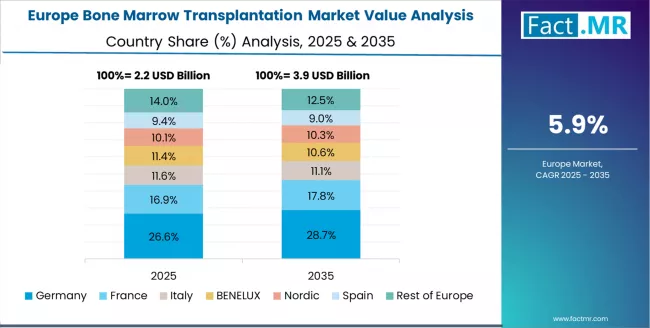
The European bone marrow transplantation market is projected to grow from USD 7,450 million in 2025 across key markets. Germany is expected to maintain its leadership position with USD 1,600 million market value in 2025, supported by its advanced medical technology infrastructure and major transplantation centers.
France follows with USD 1,300 million in 2025, driven by comprehensive healthcare programs and treatment technology development initiatives. United Kingdom holds USD 1,200 million through specialized treatment applications and clinical excellence requirements. Italy commands USD 1,050 million, while Spain accounts for USD 900 million in 2025. The rest of Europe region represents USD 1,400 million, attributed to increasing transplant adoption in Nordic countries and emerging medical facilities implementing healthcare modernization programs.
Competitive Landscape of the Bone Marrow Transplantation Market
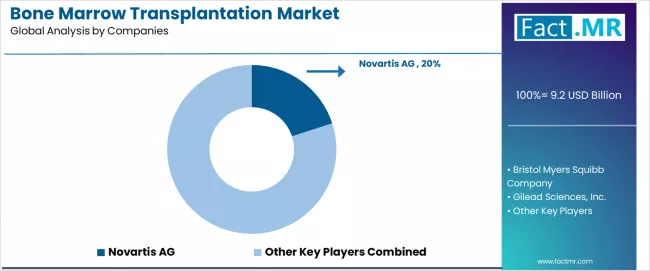
- Structure: ~15-18 credible players; top 3-5 hold ~55-60% by revenue.
- Leadership is maintained through: clinical networks, outcome data, and treatment innovation (efficacy + safety + protocol development).
- What's commoditizing: basic transplant procedures and standard conditioning regimens.
- Margin Opportunities: specialized therapies, outcome guarantees, and integration into healthcare systems (clinical protocols, patient management, long-term follow-up).
| Stakeholder | What they actually control? | Typical strengths | Typical blind spots |
|---|---|---|---|
| Global platforms | Distribution networks, clinical trial access, regulatory expertise | Broad availability, proven outcomes, multi-region support | Treatment cost pressures; local healthcare dependencies |
| Technology innovators | R&D capabilities; advanced therapies; clinical data platforms | Latest treatments first; attractive outcomes on complex cases | Clinical access outside major centers; protocol complexity |
| Regional specialists | Local expertise, regulatory knowledge, healthcare relationships | "Close to patient" support; pragmatic approaches; local standards | Technology gaps; specialist retention in specialized regions |
| Clinical-focused ecosystems | Outcome tracking, protocol development, medical education | Lowest treatment variability; comprehensive support | Clinical costs if overpromised; technology obsolescence |
| Research specialists | Clinical trials, protocol development, academic partnerships | Win research applications; flexible treatment approaches | Scalability limitations; narrow indication focus |
Key Players in the Bone Marrow Transplantation Market
- Novartis AG
- Bristol Myers Squibb Company
- Gilead Sciences Inc.
- F. Hoffmann-La Roche Ltd
- Sanofi S.A.
- Johnson & Johnson
- Medac GmbH
- Allogene Therapeutics Inc.
- bluebird bio Inc.
- Cellectis S.A.
- Miltenyi Biotec B.V. & Co. KG
- Omeros Corporation
- Kiadis Pharma N.V.
- Bellicum Pharmaceuticals Inc.
- Takeda Pharmaceutical Company Limited
Scope of the Report
| Items | Values |
|---|---|
| Quantitative Units (2025) | USD 9,200 million |
| Transplant Type | Allogeneic, Autologous |
| Indication | Leukemia, Lymphoma, Others |
| End Use | Transplant Centers, Academic Medical Institutions, Cancer Hospitals, Comprehensive Care Facilities |
| Regions Covered | North America, Latin America, Western Europe, Eastern Europe, East Asia, South Asia Pacific, Middle East & Africa |
| Countries Covered | United States, China, Germany, India, United Kingdom, Japan, South Korea, Brazil, France, Australia, and 25+ additional countries |
| Key Companies Profiled | Novartis, Bristol Myers Squibb, Gilead, Roche, Sanofi, Johnson & Johnson, Medac, Allogene, Bluebird Bio, Cellectis, Miltenyi Biotec, Omeros, Kiadis, Bellicum, Takeda |
| Additional Attributes | Dollar sales by transplant type and indication categories, regional adoption trends across East Asia, North America, and Western Europe, competitive landscape with pharmaceutical manufacturers and clinical service providers, healthcare provider preferences for treatment efficacy and patient outcomes, integration with oncology platforms and clinical protocols, innovations in cellular therapy and transplant enhancement, and development of advanced treatment solutions with enhanced performance and clinical optimization capabilities. |
Bone Marrow Transplantation Market by Segments
-
Transplant Type :
- Allogeneic
- Autologous
-
Indication :
- Leukemia
- Lymphoma
- Others
-
End Use :
- Transplant Centers
- Academic Medical Institutions
- Cancer Hospitals
- Comprehensive Care Facilities
-
Region :
- North America
- United States
- Canada
- Mexico
- Latin America
- Brazil
- Chile
- Rest of Latin America
- Western Europe
- Germany
- United Kingdom
- France
- Italy
- Spain
- Nordic
- BENELUX
- Rest of Western Europe
- Eastern Europe
- Russia
- Poland
- Rest of Eastern Europe
- East Asia
- China
- Japan
- South Korea
- South Asia Pacific
- India
- ASEAN
- Australia & New Zealand
- Rest of South Asia Pacific
- Middle East & Africa
- Kingdom of Saudi Arabia
- Other GCC Countries
- Turkey
- South Africa
- Other African Union
- Rest of Middle East & Africa
- North America
Table of Content
- Executive Summary
- Global Market Outlook
- Demand to side Trends
- Supply to side Trends
- Technology Roadmap Analysis
- Analysis and Recommendations
- Market Overview
- Market Coverage / Taxonomy
- Market Definition / Scope / Limitations
- Market Background
- Market Dynamics
- Drivers
- Restraints
- Opportunity
- Trends
- Scenario Forecast
- Demand in Optimistic Scenario
- Demand in Likely Scenario
- Demand in Conservative Scenario
- Opportunity Map Analysis
- Product Life Cycle Analysis
- Supply Chain Analysis
- Investment Feasibility Matrix
- Value Chain Analysis
- PESTLE and Porter’s Analysis
- Regulatory Landscape
- Regional Parent Market Outlook
- Production and Consumption Statistics
- Import and Export Statistics
- Market Dynamics
- Global Market Analysis 2020 to 2024 and Forecast, 2025 to 2035
- Historical Market Size Value (USD Million) Analysis, 2020 to 2024
- Current and Future Market Size Value (USD Million) Projections, 2025 to 2035
- Y to o to Y Growth Trend Analysis
- Absolute $ Opportunity Analysis
- Global Market Pricing Analysis 2020 to 2024 and Forecast 2025 to 2035
- Global Market Analysis 2020 to 2024 and Forecast 2025 to 2035, By Tranplant Type
- Introduction / Key Findings
- Historical Market Size Value (USD Million) Analysis By Tranplant Type , 2020 to 2024
- Current and Future Market Size Value (USD Million) Analysis and Forecast By Tranplant Type , 2025 to 2035
- Allogenic
- Autologous
- Y to o to Y Growth Trend Analysis By Tranplant Type , 2020 to 2024
- Absolute $ Opportunity Analysis By Tranplant Type , 2025 to 2035
- Global Market Analysis 2020 to 2024 and Forecast 2025 to 2035, By Indication
- Introduction / Key Findings
- Historical Market Size Value (USD Million) Analysis By Indication, 2020 to 2024
- Current and Future Market Size Value (USD Million) Analysis and Forecast By Indication, 2025 to 2035
- Leukemia
- Lymphoma
- Others
- Y to o to Y Growth Trend Analysis By Indication, 2020 to 2024
- Absolute $ Opportunity Analysis By Indication, 2025 to 2035
- Global Market Analysis 2020 to 2024 and Forecast 2025 to 2035, By Region
- Introduction
- Historical Market Size Value (USD Million) Analysis By Region, 2020 to 2024
- Current Market Size Value (USD Million) Analysis and Forecast By Region, 2025 to 2035
- North America
- Latin America
- Western Europe
- Eastern Europe
- East Asia
- South Asia and Pacific
- Middle East & Africa
- Market Attractiveness Analysis By Region
- North America Market Analysis 2020 to 2024 and Forecast 2025 to 2035, By Country
- Historical Market Size Value (USD Million) Trend Analysis By Market Taxonomy, 2020 to 2024
- Market Size Value (USD Million) Forecast By Market Taxonomy, 2025 to 2035
- By Country
- USA
- Canada
- Mexico
- By Tranplant Type
- By Indication
- By Country
- Market Attractiveness Analysis
- By Country
- By Tranplant Type
- By Indication
- Key Takeaways
- Latin America Market Analysis 2020 to 2024 and Forecast 2025 to 2035, By Country
- Historical Market Size Value (USD Million) Trend Analysis By Market Taxonomy, 2020 to 2024
- Market Size Value (USD Million) Forecast By Market Taxonomy, 2025 to 2035
- By Country
- Brazil
- Chile
- Rest of Latin America
- By Tranplant Type
- By Indication
- By Country
- Market Attractiveness Analysis
- By Country
- By Tranplant Type
- By Indication
- Key Takeaways
- Western Europe Market Analysis 2020 to 2024 and Forecast 2025 to 2035, By Country
- Historical Market Size Value (USD Million) Trend Analysis By Market Taxonomy, 2020 to 2024
- Market Size Value (USD Million) Forecast By Market Taxonomy, 2025 to 2035
- By Country
- Germany
- UK
- Italy
- Spain
- France
- Nordic
- BENELUX
- Rest of Western Europe
- By Tranplant Type
- By Indication
- By Country
- Market Attractiveness Analysis
- By Country
- By Tranplant Type
- By Indication
- Key Takeaways
- Eastern Europe Market Analysis 2020 to 2024 and Forecast 2025 to 2035, By Country
- Historical Market Size Value (USD Million) Trend Analysis By Market Taxonomy, 2020 to 2024
- Market Size Value (USD Million) Forecast By Market Taxonomy, 2025 to 2035
- By Country
- Russia
- Poland
- Hungary
- Balkan & Baltic
- Rest of Eastern Europe
- By Tranplant Type
- By Indication
- By Country
- Market Attractiveness Analysis
- By Country
- By Tranplant Type
- By Indication
- Key Takeaways
- East Asia Market Analysis 2020 to 2024 and Forecast 2025 to 2035, By Country
- Historical Market Size Value (USD Million) Trend Analysis By Market Taxonomy, 2020 to 2024
- Market Size Value (USD Million) Forecast By Market Taxonomy, 2025 to 2035
- By Country
- China
- Japan
- South Korea
- By Tranplant Type
- By Indication
- By Country
- Market Attractiveness Analysis
- By Country
- By Tranplant Type
- By Indication
- Key Takeaways
- South Asia and Pacific Market Analysis 2020 to 2024 and Forecast 2025 to 2035, By Country
- Historical Market Size Value (USD Million) Trend Analysis By Market Taxonomy, 2020 to 2024
- Market Size Value (USD Million) Forecast By Market Taxonomy, 2025 to 2035
- By Country
- India
- ASEAN
- Australia & New Zealand
- Rest of South Asia and Pacific
- By Tranplant Type
- By Indication
- By Country
- Market Attractiveness Analysis
- By Country
- By Tranplant Type
- By Indication
- Key Takeaways
- Middle East & Africa Market Analysis 2020 to 2024 and Forecast 2025 to 2035, By Country
- Historical Market Size Value (USD Million) Trend Analysis By Market Taxonomy, 2020 to 2024
- Market Size Value (USD Million) Forecast By Market Taxonomy, 2025 to 2035
- By Country
- Kingdom of Saudi Arabia
- Other GCC Countries
- Turkiye
- South Africa
- Other African Union
- Rest of Middle East & Africa
- By Tranplant Type
- By Indication
- By Country
- Market Attractiveness Analysis
- By Country
- By Tranplant Type
- By Indication
- Key Takeaways
- Key Countries Market Analysis
- USA
- Pricing Analysis
- Market Share Analysis, 2024
- By Tranplant Type
- By Indication
- Canada
- Pricing Analysis
- Market Share Analysis, 2024
- By Tranplant Type
- By Indication
- Mexico
- Pricing Analysis
- Market Share Analysis, 2024
- By Tranplant Type
- By Indication
- Brazil
- Pricing Analysis
- Market Share Analysis, 2024
- By Tranplant Type
- By Indication
- Chile
- Pricing Analysis
- Market Share Analysis, 2024
- By Tranplant Type
- By Indication
- Germany
- Pricing Analysis
- Market Share Analysis, 2024
- By Tranplant Type
- By Indication
- UK
- Pricing Analysis
- Market Share Analysis, 2024
- By Tranplant Type
- By Indication
- Italy
- Pricing Analysis
- Market Share Analysis, 2024
- By Tranplant Type
- By Indication
- Spain
- Pricing Analysis
- Market Share Analysis, 2024
- By Tranplant Type
- By Indication
- France
- Pricing Analysis
- Market Share Analysis, 2024
- By Tranplant Type
- By Indication
- India
- Pricing Analysis
- Market Share Analysis, 2024
- By Tranplant Type
- By Indication
- ASEAN
- Pricing Analysis
- Market Share Analysis, 2024
- By Tranplant Type
- By Indication
- Australia & New Zealand
- Pricing Analysis
- Market Share Analysis, 2024
- By Tranplant Type
- By Indication
- China
- Pricing Analysis
- Market Share Analysis, 2024
- By Tranplant Type
- By Indication
- Japan
- Pricing Analysis
- Market Share Analysis, 2024
- By Tranplant Type
- By Indication
- South Korea
- Pricing Analysis
- Market Share Analysis, 2024
- By Tranplant Type
- By Indication
- Russia
- Pricing Analysis
- Market Share Analysis, 2024
- By Tranplant Type
- By Indication
- Poland
- Pricing Analysis
- Market Share Analysis, 2024
- By Tranplant Type
- By Indication
- Hungary
- Pricing Analysis
- Market Share Analysis, 2024
- By Tranplant Type
- By Indication
- Kingdom of Saudi Arabia
- Pricing Analysis
- Market Share Analysis, 2024
- By Tranplant Type
- By Indication
- Turkiye
- Pricing Analysis
- Market Share Analysis, 2024
- By Tranplant Type
- By Indication
- South Africa
- Pricing Analysis
- Market Share Analysis, 2024
- By Tranplant Type
- By Indication
- USA
- Market Structure Analysis
- Competition Dashboard
- Competition Benchmarking
- Market Share Analysis of Top Players
- By Regional
- By Tranplant Type
- By Indication
- Competition Analysis
- Competition Deep Dive
- Novartis AG
- Overview
- Product Portfolio
- Profitability by Market Segments (Product/Age /Sales Channel/Region)
- Sales Footprint
- Strategy Overview
- Marketing Strategy
- Product Strategy
- Channel Strategy
- Bristol Myers Squibb Company
- Gilead Sciences, Inc.
- F. Hoffmann-La Roche Ltd
- Sanofi S.A.
- Johnson & Johnson
- Medac GmbH
- Allogene Therapeutics, Inc.
- bluebird bio, Inc.
- Cellectis S.A.
- Miltenyi Biotec B.V. & Co. KG
- Omeros Corporation
- Kiadis Pharma N.V.
- Bellicum Pharmaceuticals, Inc.
- Takeda Pharmaceutical Company Limited
- Novartis AG
- Competition Deep Dive
- Assumptions & Acronyms Used
- Research Methodology
List Of Table
- Table 1: Global Market Value (USD Million) Forecast by Region, 2020 to 2035
- Table 2: Global Market Value (USD Million) Forecast by Tranplant Type , 2020 to 2035
- Table 3: Global Market Value (USD Million) Forecast by Indication, 2020 to 2035
- Table 4: North America Market Value (USD Million) Forecast by Country, 2020 to 2035
- Table 5: North America Market Value (USD Million) Forecast by Tranplant Type , 2020 to 2035
- Table 6: North America Market Value (USD Million) Forecast by Indication, 2020 to 2035
- Table 7: Latin America Market Value (USD Million) Forecast by Country, 2020 to 2035
- Table 8: Latin America Market Value (USD Million) Forecast by Tranplant Type , 2020 to 2035
- Table 9: Latin America Market Value (USD Million) Forecast by Indication, 2020 to 2035
- Table 10: Western Europe Market Value (USD Million) Forecast by Country, 2020 to 2035
- Table 11: Western Europe Market Value (USD Million) Forecast by Tranplant Type , 2020 to 2035
- Table 12: Western Europe Market Value (USD Million) Forecast by Indication, 2020 to 2035
- Table 13: Eastern Europe Market Value (USD Million) Forecast by Country, 2020 to 2035
- Table 14: Eastern Europe Market Value (USD Million) Forecast by Tranplant Type , 2020 to 2035
- Table 15: Eastern Europe Market Value (USD Million) Forecast by Indication, 2020 to 2035
- Table 16: East Asia Market Value (USD Million) Forecast by Country, 2020 to 2035
- Table 17: East Asia Market Value (USD Million) Forecast by Tranplant Type , 2020 to 2035
- Table 18: East Asia Market Value (USD Million) Forecast by Indication, 2020 to 2035
- Table 19: South Asia and Pacific Market Value (USD Million) Forecast by Country, 2020 to 2035
- Table 20: South Asia and Pacific Market Value (USD Million) Forecast by Tranplant Type , 2020 to 2035
- Table 21: South Asia and Pacific Market Value (USD Million) Forecast by Indication, 2020 to 2035
- Table 22: Middle East & Africa Market Value (USD Million) Forecast by Country, 2020 to 2035
- Table 23: Middle East & Africa Market Value (USD Million) Forecast by Tranplant Type , 2020 to 2035
- Table 24: Middle East & Africa Market Value (USD Million) Forecast by Indication, 2020 to 2035
List Of Figures
- Figure 1: Global Market Pricing Analysis
- Figure 2: Global Market Value (USD Million) Forecast 2020-2035
- Figure 3: Global Market Value Share and BPS Analysis by Tranplant Type , 2025 and 2035
- Figure 4: Global Market Y to o to Y Growth Comparison by Tranplant Type , 2025-2035
- Figure 5: Global Market Attractiveness Analysis by Tranplant Type
- Figure 6: Global Market Value Share and BPS Analysis by Indication, 2025 and 2035
- Figure 7: Global Market Y to o to Y Growth Comparison by Indication, 2025-2035
- Figure 8: Global Market Attractiveness Analysis by Indication
- Figure 9: Global Market Value (USD Million) Share and BPS Analysis by Region, 2025 and 2035
- Figure 10: Global Market Y to o to Y Growth Comparison by Region, 2025-2035
- Figure 11: Global Market Attractiveness Analysis by Region
- Figure 12: North America Market Incremental Dollar Opportunity, 2025-2035
- Figure 13: Latin America Market Incremental Dollar Opportunity, 2025-2035
- Figure 14: Western Europe Market Incremental Dollar Opportunity, 2025-2035
- Figure 15: Eastern Europe Market Incremental Dollar Opportunity, 2025-2035
- Figure 16: East Asia Market Incremental Dollar Opportunity, 2025-2035
- Figure 17: South Asia and Pacific Market Incremental Dollar Opportunity, 2025-2035
- Figure 18: Middle East & Africa Market Incremental Dollar Opportunity, 2025-2035
- Figure 19: North America Market Value Share and BPS Analysis by Country, 2025 and 2035
- Figure 20: North America Market Value Share and BPS Analysis by Tranplant Type , 2025 and 2035
- Figure 21: North America Market Y to o to Y Growth Comparison by Tranplant Type , 2025-2035
- Figure 22: North America Market Attractiveness Analysis by Tranplant Type
- Figure 23: North America Market Value Share and BPS Analysis by Indication, 2025 and 2035
- Figure 24: North America Market Y to o to Y Growth Comparison by Indication, 2025-2035
- Figure 25: North America Market Attractiveness Analysis by Indication
- Figure 26: Latin America Market Value Share and BPS Analysis by Country, 2025 and 2035
- Figure 27: Latin America Market Value Share and BPS Analysis by Tranplant Type , 2025 and 2035
- Figure 28: Latin America Market Y to o to Y Growth Comparison by Tranplant Type , 2025-2035
- Figure 29: Latin America Market Attractiveness Analysis by Tranplant Type
- Figure 30: Latin America Market Value Share and BPS Analysis by Indication, 2025 and 2035
- Figure 31: Latin America Market Y to o to Y Growth Comparison by Indication, 2025-2035
- Figure 32: Latin America Market Attractiveness Analysis by Indication
- Figure 33: Western Europe Market Value Share and BPS Analysis by Country, 2025 and 2035
- Figure 34: Western Europe Market Value Share and BPS Analysis by Tranplant Type , 2025 and 2035
- Figure 35: Western Europe Market Y to o to Y Growth Comparison by Tranplant Type , 2025-2035
- Figure 36: Western Europe Market Attractiveness Analysis by Tranplant Type
- Figure 37: Western Europe Market Value Share and BPS Analysis by Indication, 2025 and 2035
- Figure 38: Western Europe Market Y to o to Y Growth Comparison by Indication, 2025-2035
- Figure 39: Western Europe Market Attractiveness Analysis by Indication
- Figure 40: Eastern Europe Market Value Share and BPS Analysis by Country, 2025 and 2035
- Figure 41: Eastern Europe Market Value Share and BPS Analysis by Tranplant Type , 2025 and 2035
- Figure 42: Eastern Europe Market Y to o to Y Growth Comparison by Tranplant Type , 2025-2035
- Figure 43: Eastern Europe Market Attractiveness Analysis by Tranplant Type
- Figure 44: Eastern Europe Market Value Share and BPS Analysis by Indication, 2025 and 2035
- Figure 45: Eastern Europe Market Y to o to Y Growth Comparison by Indication, 2025-2035
- Figure 46: Eastern Europe Market Attractiveness Analysis by Indication
- Figure 47: East Asia Market Value Share and BPS Analysis by Country, 2025 and 2035
- Figure 48: East Asia Market Value Share and BPS Analysis by Tranplant Type , 2025 and 2035
- Figure 49: East Asia Market Y to o to Y Growth Comparison by Tranplant Type , 2025-2035
- Figure 50: East Asia Market Attractiveness Analysis by Tranplant Type
- Figure 51: East Asia Market Value Share and BPS Analysis by Indication, 2025 and 2035
- Figure 52: East Asia Market Y to o to Y Growth Comparison by Indication, 2025-2035
- Figure 53: East Asia Market Attractiveness Analysis by Indication
- Figure 54: South Asia and Pacific Market Value Share and BPS Analysis by Country, 2025 and 2035
- Figure 55: South Asia and Pacific Market Value Share and BPS Analysis by Tranplant Type , 2025 and 2035
- Figure 56: South Asia and Pacific Market Y to o to Y Growth Comparison by Tranplant Type , 2025-2035
- Figure 57: South Asia and Pacific Market Attractiveness Analysis by Tranplant Type
- Figure 58: South Asia and Pacific Market Value Share and BPS Analysis by Indication, 2025 and 2035
- Figure 59: South Asia and Pacific Market Y to o to Y Growth Comparison by Indication, 2025-2035
- Figure 60: South Asia and Pacific Market Attractiveness Analysis by Indication
- Figure 61: Middle East & Africa Market Value Share and BPS Analysis by Country, 2025 and 2035
- Figure 62: Middle East & Africa Market Value Share and BPS Analysis by Tranplant Type , 2025 and 2035
- Figure 63: Middle East & Africa Market Y to o to Y Growth Comparison by Tranplant Type , 2025-2035
- Figure 64: Middle East & Africa Market Attractiveness Analysis by Tranplant Type
- Figure 65: Middle East & Africa Market Value Share and BPS Analysis by Indication, 2025 and 2035
- Figure 66: Middle East & Africa Market Y to o to Y Growth Comparison by Indication, 2025-2035
- Figure 67: Middle East & Africa Market Attractiveness Analysis by Indication
- Figure 68: Global Market - Tier Structure Analysis
- Figure 69: Global Market - Company Share Analysis
- FAQs -
How big is the bone marrow transplantation market in 2025?
The global bone marrow transplantation market is estimated to be valued at USD 9,200.0 million in 2025.
What will be the size of bone marrow transplantation market in 2035?
The market size for the bone marrow transplantation market is projected to reach USD 17,762.3 million by 2035.
How much will be the bone marrow transplantation market growth between 2025 and 2035?
The bone marrow transplantation market is expected to grow at a 6.8% CAGR between 2025 and 2035.
What are the key product types in the bone marrow transplantation market?
The key product types in bone marrow transplantation market are allogenic and autologous.
Which indication segment to contribute significant share in the bone marrow transplantation market in 2025?
In terms of indication, leukemia segment to command 40.0% share in the bone marrow transplantation market in 2025.